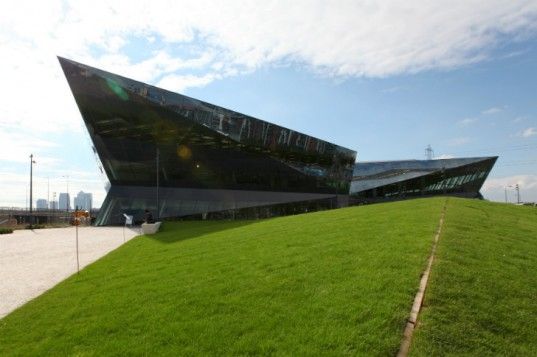Ways & Means is a weekly column by Mark Alan Hughes on economics, politics and sustainability in Philadelphia.
This month, Siemens Corporation opened a new exhibition center and corporate headquarters in London for its Sustainable Cities initiative. It’s called The Crystal, and is perhaps best described as LEED-certified monument to the corporation’s confidence in cities both as a force for good and a source of profit.
The German multinational conglomerate has its hands in nearly all significant global industries: Technology, energy, healthcare, infrastructure and finance. The fact that the company is now investing heavily in services and products intended to make cities run better, and more sustainably, means that issues that many of care about — energy efficiency, water conservation, smartgrid interoperability — are now fodder for big business just as cars, oil and industry have been in the past.
While its easy to be cynical of a corporation’s motivations for an event like this, its important to remember that cities experiencing dark financial moments increasingly depend on allies from the private sector to help them keep the lights on.
With that scary thought likely in mind, some 300 mayors and thought leaders from around the world turned out for opening events at The Crystal. (Disclosure: I was invited to the event by Siemens and the corporation paid for part of my travel expenses, as it did for other attendees.) UN Under-Secretary-General and UN-Habitat Executive Director Joan Clos opened the event with a discussion framed by simple question: Why were the UN and Siemens — ultimate examples of the public and private sectors — co-sponsoring a conference? He then offered three sets of facts to provide an answer.

Joan Clos
First, this is the urban century. For the first time, most humans live in cities. In 1800, cities held 2 percent of the world population. In 1900, 20 percent. In 2000, 50 percent. And by 2050, 65 percent. Because of overall population growth, that last 50-year increment will mean a doubling of the absolute size of the urban population.
Second, we’re doing what we know, not what we should. We have a very reliable model of how to build buildings. Around the world, people are financing, constructing and profiting from buildings on a 3-5-year turn around. But we do not have a well-understood model of how to build cities, which require public goods like infrastructure that have life cycles of at least 20 years. And so in most emerging economies, where urban growth is exploding, we are building buildings, not cities.
Third, we’re losing lots of potential money. By building buildings without sufficient infrastructure (streets, open space), we are locking billions of people and untold wealth into inefficient settlements. Research gathered by Habitat from scholars around the world suggests that a surprisingly precise window of 45-50 percent of urban land should be devoted to infrastructure, about two-thirds going to streets and one-third to open space. Devoting more than that range to infrastructure reduces the total value of the city by reducing the amount of buildable land. But devoting less than that to infrastructure also reduces the total value of the city, because congestion chokes off the value of the larger amount of buildable land.
All the world’s most valuable cities fall within this 45-50 percent range of land set aside as unbuildable, Clos said. In Manhattan, for example, 49 percent of the land is devoted to streets and open space and 51 percent to buildings. But in most emerging cities, the amount of land devoted to streets is far less — about 10 percent. As a result, cities in the developed world can accommodate eight cars for every 10 inhabitants, while cities in the emerging economies are congested with only one car for every 10 inhabitants.
The point is not to build cities that can handle lots of cars, but cities that have enough room to provide the shared infrastructure needed to provide for circulation of all kinds, whether it be transit, vehicles or fiber optics. For Clos, this is why have a conference of Habitat plus the private sector: Because only the public sphere can create the conditions for maximizing private value.
For Clos, the essence of city planning is simple and extraordinarily important: Providing the enforceable legal agreement on what land is buildable and not buildable. Getting that agreement right creates the value that makes possible every other public goal at the municipal level. Capturing a share of that value has been a major topic in Next American City, both in conventional and innovative ways. The private sector needs to support that value capture in order to make possible, in turn, that essential public planning.
The remarks made by Roland Busch, Siemens’ CEO for infrastructure and cities, made for some powerful harmony when he made the same argument in a different key. For Busch, cities aren’t the challenge but the solution. The best way, and perhaps the only way, to absorb increasing global population and affluence is through urbanization. Building cities is our best hope for a sustainable, survivable future because cities are the most efficient means of using limited natural resources to support human life.

The public and civic sector has led the way in revamping Philly’s Dilworth Plaza. Credit: Center City District
A second Siemens senior executive, the widely admired Pedro Miranda, also drove home the importance of cities. He noted that 22 percent of the world’s population lives in the 600 largest cities, but that these 600 cities account for 51 percent of the world’s total Gross Domestic Product (GDP), a measure of economic output. Both Busch and Miranda agreed that public planning is essential to achieving these benefits of cities, essential to both creating value and conserving resources.
Listening to this tag team led by the public and private sectors, I couldn’t help but feel Philadelphia, both at home and through Mayor Michael Nutter’s national profile, could do more to activate the private-sector interest in a stronger cities. The public and civic sector are admirably leading the parade in Philadelphia’s comeback, including the reform of our basic planning process and the revival of our great public spaces, such as the redevelopment of Dillworth Plaza.
But as we take it to the next level and grapple with the big enchalada of value creation and value capture, the private sector needs to step up and acknowledge that sharing that value with the public is the price we pay for the conditions that make wealth possible.
Mark Alan Hughes teaches at PennDesign and was an Expert Adviser to the North American Sustainable Cities Index produced jointly by Siemens and The Economist magazine in 2011.

Mark Alan Hughes is a Distinguished Senior Fellow at PennDesign and an Investigator at the US Department Of Energy’s Energy Efficient Buildings Hub at the Philadelphia Navy Yard. He is a Faculty Fellow of the Penn Institute for Urban Research, a Senior Fellow of the Wharton School’s Initiative for Global Environmental Leadership, and a Distinguished Scholar in Residence at Penn’s Fox Leadership Program. He has been a senior fellow at the Brookings Institution, the Urban Institute, and a senior adviser at the Ford Foundation. He was the Chief Policy Adviser to Mayor Michael Nutter and the founding Director of Sustainability for the City of Philadelphia, where he led the creation of the Greenworks plan. Hughes holds a B.A. from Swarthmore and a Ph.D. from Penn, joined the Princeton faculty in 1986 at the age of 25, has taught at Penn since 1999, and is widely published in the leading academic journals of several disciplines, including Economic Geography, Urban Economics, Policy Analysis and Management, and the Journal of the American Planning Association, for which he won the National Planning Award in 1992.
















